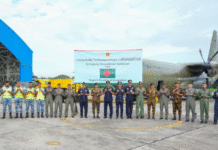Travel restrictions on Ebola patients and the absence of direct air links with the affected West African countries made the deadly virus making its way to Bangladesh “a remote possibility”.
But the viral disease that World Health Organisation terms as “one of the world’s most virulent ailments” with a 90 percent fatality rate appears as a concern after the UN agency Friday declared it an “international health emergency”.
The national disease monitoring arm, IEDCR, is keeping a close watch and had already added the virus in an ongoing doctors training programme on emerging diseases on Saturday.
But IEDCR director Prof Mahmudur Rahman considers Bangladesh “a low-risk” country.
“It’s a remote possibility (of the virus coming to Bangladesh),” he told bdnews24.com, analysing the trend of the virus and WHO’s advice.
WHO advised affected states — Sierra Leone, Guinea, and Liberia – to conduct “exit screening” of all persons at international airports, seaports and major land crossings, for unexplained febrile illness consistent with potential Ebola infection.
It also advised that any person with an illness consistent with Ebola “should not be allowed to travel unless the travel is part of an appropriate medical evacuation”.
“There should be no international travel of Ebola contacts or cases, unless the travel is part of an appropriate medical evacuation,” WHO also advised.
It has also asked countries where the virus has not spread so far not to impose any “general ban on international travel or trade”.
Prof Rahman said, given the very high mortality rate, it would also be difficult for a person to carry the virus from one country to another.
He said the risk of infection was also very low since person‐to‐person transmission results from direct contact with the body fluids or secretions of an infected patient.
Ebola, mainly an animal disease, was first reported in Congo in 1976. The disease got the name after a river in Congo.
But, last year, there were alarming outbreaks in West African countries –Sierra Leone, Guinea, and Liberia — where at least 1,711 people have so far been infected, of whom 932 have died.
The disease remained in the state of an epidemic in that part of the world.
WHO blamed weak health systems in the currently affected countries, lacking in human, financial and material resources at the time of categorising Ebola as an international emergency.
The only open route via which the virus might travel to Bangladesh is its peacekeepers posted in that region.
But sources in the armed forces said a fresh batch recently deployed in those states mean they would not come back soon.
Director General Medical Services of the Bangladesh Armed Forces Major General Md Abdul Kalam Azad also ruled out any possibility of importing the virus by the peacekeepers.
“We have oriented them with WHO help,” he told bdnews24.com on Saturday, adding that they would send more personal protective equipment (PPE) for the peacekeepers from Dhaka.
“We’ll receive 100 PPE from IEDCR on Sunday,” he said, adding that about 800 Bangladeshi peacekeepers had been deployed in that region.
“None of them has been infected,” he said.
The disease has no proven cures and there is no vaccine to prevent infection.
So, treatment focuses on alleviating symptoms such as fever, vomiting and diarrhoea – all of which can contribute to severe dehydration.
But creating awareness about the disease symptoms also appeared to pose a challenge as they were similar to common illnesses in Bangladesh –fever and diarrhoea.
The IEDCR director urged everyone not to spread panic.
“There is no chance of getting Ebola if you don’t come into direct contact with an Ebola infected person’s secretions, blood,” he said, “And we don’t have Ebola right now”.
He said there was also no reason to launch an awareness campaign right now. “It can sometime cause an overreaction.”
“We have all the preparations,” he assured, adding that the preparedness for to counter the nipah virus would help in this regard.
“We can detect any suspect and investigate and collect sample,” he said.
Bangladesh, like many countries, currently did not have facilities to test the Ebola virus since it was endemic to a particular zone, he said.
“But we can send samples within 24 hours to US CDC for testing,” he said, adding that WHO would give test kits “when we need them”.
“We have our laboratories and manpower (to do the tests),” he said.
Bangladesh being a hotspot of infectious diseases over the years strengthened its surveillance system to detect any new disease.
“We train doctors every year,” Prof Rahman said. Even doctors at private hospitals were being trained.
“We can detect any new disease as soon as it emerges,” he said, his confidence based on the IEDCR’s experience in identifying pandemic influence and ongoing Middle-East Respiratory Syndrome (MERS) Coronavirus.
The IEDCR director, however, said Bangladeshis always responded well to emergencies.
“We did not let any of those (pandemic influenza, nipah) outbreaks out of control,” he said.
Source: bdnews24










